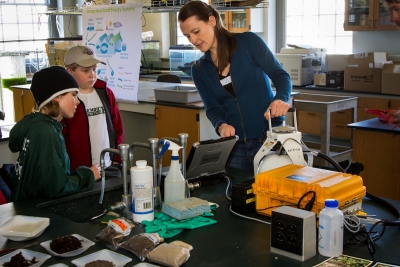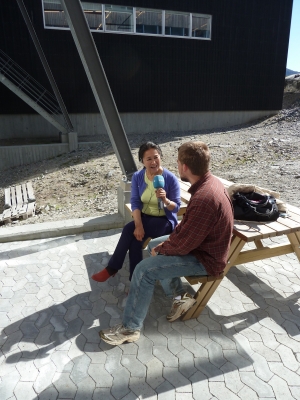By: Lee McDavid, Arctic Program Manager, Dartmouth College, Dickey Center for International Understanding
A dozen teenagers from Greenland, Denmark, and the U.S. are twirling across the rolling tundra on the edge of the Greenland Ice Sheet laughing, looking as though they're just fooling around. But Dartmouth graduate students Julia Bradley-Cook and Ruth Heindel are leading them in a "carbon cycle dance" as a way to understand photosynthesis and other biological processes important to global warming.
Julia and Ruth are two of 24 Dartmouth doctoral students in earth sciences, ecology and evolutionary biology, and engineering who are fellows in the Integrated Graduate Education and Research Traineeship (IGERT) program, which is funded by the National Science Foundation.The Dartmouth IGERT, run by the Institute of Arctic Studies at the Dickey Center for International Understanding at Dartmouth, is a program in polar environmental change. While it is fundamentally an interdisciplinary curriculum in science, engineering, and the human dimensions of changing climate it also emphasizes science communication. What Julia and Ruth are doing with their students on the tundra may look silly, but their intent is serious—they are practicing one of the primary goals of the Dartmouth IGERT: to make science understandable, even fun, to yet another challenging audience.

"While dancing we talk about the added complexities of permafrost, a warming climate, and human consumption of fossil fuels," Ruth explains. "We also want to give the students a feeling for the work that we do each day in the field."
People often pick up science information from the media, not from the researchers who study the issues. But increasingly, scientists and engineers are being called upon to share their knowledge directly with policymakers and the public. Effective science communication is important to increasing the public's understanding of critical issues such as climate change, biodiversity, and energy policy.
For the past four years IGERT graduate students have been communicating with all sorts of unlikely audiences explaining properties of snow and ice, changes to the Greenland Ice Sheet, the composition of ice cores, the history of the earth's climate, threats to coastal communities from melting ice, and complex Arctic policy issues as well basic science concepts, in the hope that science, engineering, environmental change, and the research process will be more understandable.

Lauren Culler, who this summer completed a PhD in ecology and evolutionary biology, has become known as "The Mosquito Lady." In the course of her IGERT fellowship, she's talked to high school students, fly fishers, Greenland public radio, and landscape contractors, to name just a few. They even know her in Nunavut, where a local newspaper wrote a detailed article about her mosquito research and the consequences for Arctic communities of insect-borne diseases moving north. In Greenland she invited the community to share their local knowledge about climate variation and mosquito abundance to improve the research. Then she created a poster, translated into Kalaallisut, Danish, and English that diagrammed the life cycle of the mosquito and distributed it in Kangerlussuaq, Greenland. It became the talk of the town.
For the past two years, a group of IGERT students have tackled one of the most challenging audiences: excited four-year-olds at the Dartmouth Day Care Center. The kids tried on mukluk boots, held a whale's baleen and a musk ox pelt, and looked at maps of Greenland and diagrams of snow and ice. It's an educational show and tell.
"IGERT fellows learn to engage in different ways in order to improve their communication skills and to help increase the public's understanding of science," explains Ross Virginia, professor of environmental science and Principal Investigator (PI) of the Dartmouth IGERT.

For the past two years, students in the spring IGERT course have created short science videos for use in Greenlandic schools. "Greenlandic students want to understand why scientists come from around the world to study their ice sheet and the rapidly changing Arctic environment," explains Virginia, "so the IGERTs created videos to help explain climate change and introduce themselves as young people doing science. We hope they will inspire more Greenlandic students to study science."
The graduate students have particularly enjoyed working with an NSF outreach initiative, the Joint Science Education Program (JSEP). JSEP brings together high school students from the U.S., Greenland, and Denmark to study science in Greenland. Dartmouth IGERT students have led field trips in Kangerlussuaq and at the NSF research facility, Summit Station, in Greenland so this international mix of students can study science as well as the process of scientific research and learn from one another.

IGERT students are not just thrown into a mosh pit with four-year-olds and climate skeptics. They receive training in public speaking, video production, social media, and how to give a "30 second elevator speech" about their research to the public as well as government officials, community leaders, and experts in fields other than their own. The result has been dozens of presentations, a pub talk, a YouTube channel, radio and newspaper interviews, an Antarctic webcast, a lecture on an ice breaker, a photo in a roadside park display, and a bevy of enthusiastic followers of the IGERT student blog.
Over the past five years, the IGERT program graduated earth scientists, ecologists, and engineers who have communication skills that prepare them to face a world where the public's science literacy may hinge in part on the success of a carbon cycle dance.
For further information about the Dartmouth IGERT program, contact Lee McDavid (Lee.McDavid [at] dartmouth.edu).
